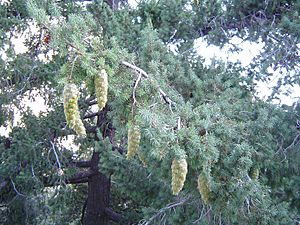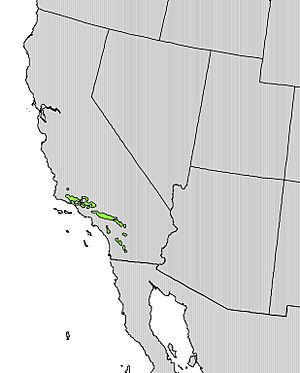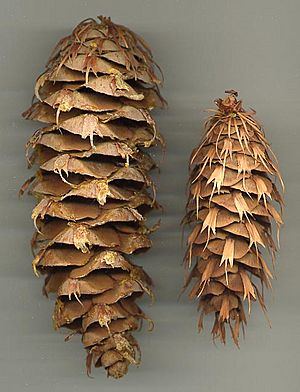Bigcone spruce facts for kids
Quick facts for kids Bigcone spruce |
|
|---|---|
 |
|
| A Bigcone Douglas-fir tree at Mount San Antonio | |
| Conservation status | |
| Scientific classification | |
| Genus: |
Pseudotsuga
|
| Species: |
macrocarpa
|
 |
|
| Where the Bigcone Douglas-fir naturally grows | |
The Pseudotsuga macrocarpa, often called the bigcone spruce or bigcone Douglas-fir, is a type of evergreen tree. It's a conifer, which means it produces cones. This tree is special because it has the largest cones of all the Douglas-fir trees, which is why it's called "bigcone."
You can find this tree in the mountains of southern California. It grows from the San Rafael Mountains in central Santa Barbara County down to the Cuyamaca Mountains in San Diego County. It likes to grow on slopes and can handle some shade.
Contents
What's in a Name?
Even though it's often called "bigcone spruce," this tree is actually a type of Douglas-fir. It's not a true spruce tree. This can be a bit confusing, but the name "bigcone spruce" is still used a lot, even in names of places!
Meet the Bigcone Douglas-fir
This tree usually grows between 15 and 30 meters (about 50 to 100 feet) tall. Its trunk can be quite wide, from 56 to 155 centimeters (about 2 to 5 feet) across. It grows straight and has a cone-shaped top.
The bark of the bigcone Douglas-fir is very thick and deeply ridged. It's made of thin, woody plates with thick layers of cork. For very old trees, the bark can be 15 to 20 centimeters (6 to 8 inches) thick! Its main branches spread out, and smaller branches hang down.
Its leaves are like needles, about 2.5 to 4.5 centimeters (1 to 1.8 inches) long. These needles stay on the tree for about five years before they fall off.
The female cones are really big, measuring 11 to 17 centimeters (4.3 to 6.7 inches) long. They are much larger and have thicker scales than other Douglas-fir cones. The seeds inside are large and heavy, about 10 mm long and 8 mm wide. They have a small, rounded wing, so they are usually spread by birds or mammals, not by the wind. Trees start making seeds when they are about 20 years old.
The biggest known bigcone Douglas-fir is about 53 meters (174 feet) tall. Its trunk is 231 centimeters (91 inches) wide. Experts think this giant tree is between 600 and 700 years old!
Where Does It Live?
The bigcone Douglas-fir only grows in certain parts of California. It loves a Mediterranean climate, which means hot, dry summers and mild, wet winters. In the San Gabriel Mountains, these trees get about 75 centimeters (30 inches) of rain each year.
You can find these trees at different heights, from 300 to 2,700 meters (about 1,000 to 8,900 feet) above sea level. At lower elevations, they grow near streams in cool, shady canyons. Higher up, they can be found on hillsides, ridges, and even steep slopes.
Here are some of the mountain ranges where you can find the bigcone Douglas-fir:

Life in the Forest
The bigcone Douglas-fir has some amazing ways to survive wildfires. Its bark is very thick, which protects it. Also, it has special buds on its branches that can sprout new growth even after a fire burns off all the smaller branches. This means a tree that looks dead can become green again the next spring! Wildfires happen often in the chaparral areas where these trees grow, usually every 15 to 50 years.
Bigcone Douglas-fir trees often grow close to canyon live oak trees. They like to start growing in the shade of the oaks. After about 50 years, they grow taller than the oak trees.
Many other plants live near bigcone Douglas-fir trees. Some common trees include:
- Bigleaf maple (Acer macrophyllum)
- California bay laurel (Umbellularia californica)
- Gray pine (Pinus sabineana)
- White alder (Alnus rhombifolia)
Some shrubs you might see are:
- Bigpod ceanothus (Ceanothus megacarpus)
- Red shank (Adenostoma sparsifolium)
- Eastwood manzanita (Arctostaphylos glandulosa)
- Toyon (Heteromoles arbutifolia)
- Different types of sage (Salvia)
- Coastal sage scrub oak (Quercus dumosa)
The ground cover is usually not very thick, but you might find:
- California buckwheat (Eriogonum fasciculatum)
- Wild onion (Allium species)
- Scarlet beardtongue (Penstemon ternatus)
- Giant chain fern (Woodwardia fimbriata)
- Western bracken (Pteridium aquilinum var. pubescens)
Fire and the Forest
Scientists are worried that bigcone Douglas-fir populations might be shrinking. This is because wildfires are becoming bigger and happening more often. Studies show that after major fires, there are fewer bigcone Douglas-fir trees than there used to be.
One tree that competes with the bigcone Douglas-fir is the incense cedar. After a big fire, incense cedar seedlings often grow much faster than bigcone Douglas-fir seedlings. For example, after the Station fire in 2009, there were about 20 cedar seedlings for every 1 bigcone Douglas-fir seedling in some areas.
Scientists are looking into how these trees grow back after fires. They are also studying how fungi in the soil might help the seeds grow, especially in dry areas. Collecting seeds from these trees, especially in years when they produce many cones, is also important. This helps experts understand how the trees might survive with future climate changes.
This tree is being considered for planting in more dry places. It's good at handling drought, fire, insects, and pollution. Its strong roots and ability to grow in different soils are also helpful. Sometimes, the needles on older trees turn yellow and fall off, making the tree look dead. But often, it sprouts new growth within two years! Scientists aren't sure why this happens, but it might be due to drought or insects.
How We Use This Tree
Home for Wildlife
Bigcone Douglas-fir forests provide homes for many animals. These include black-tailed deer, black bear, and various small animals. Black bears in the San Bernardino Mountains especially like these trees in the spring.
The seeds of the bigcone Douglas-fir are a food source for different kinds of rodents and birds.
Helping Nature Recover
The bigcone Douglas-fir is used to help restore watersheds and natural habitats. The Los Angeles County Department of Forestry has planted many of these trees for this reason over the past 50 years.
Scientists are also looking at mixing bigcone Douglas-fir with Coast Douglas-fir. These mixed trees, called hybrids, might be good for planting in drier areas where Coast Douglas-firs usually grow. These hybrid trees produce good quality wood and can handle dry conditions better, thanks to the bigcone Douglas-fir's drought tolerance.
Wood and Timber
Currently, there isn't a big market for bigcone Douglas-fir wood. This is because the trees don't grow everywhere, and it's hard to get to them. The wood is heavy, hard, and has a fine grain, but it doesn't last very long.
In the past, people in the local areas used the wood for fuel and lumber (wood for building).
Images for kids
See also
 In Spanish: Pseudotsuga macrocarpa para niños
In Spanish: Pseudotsuga macrocarpa para niños







